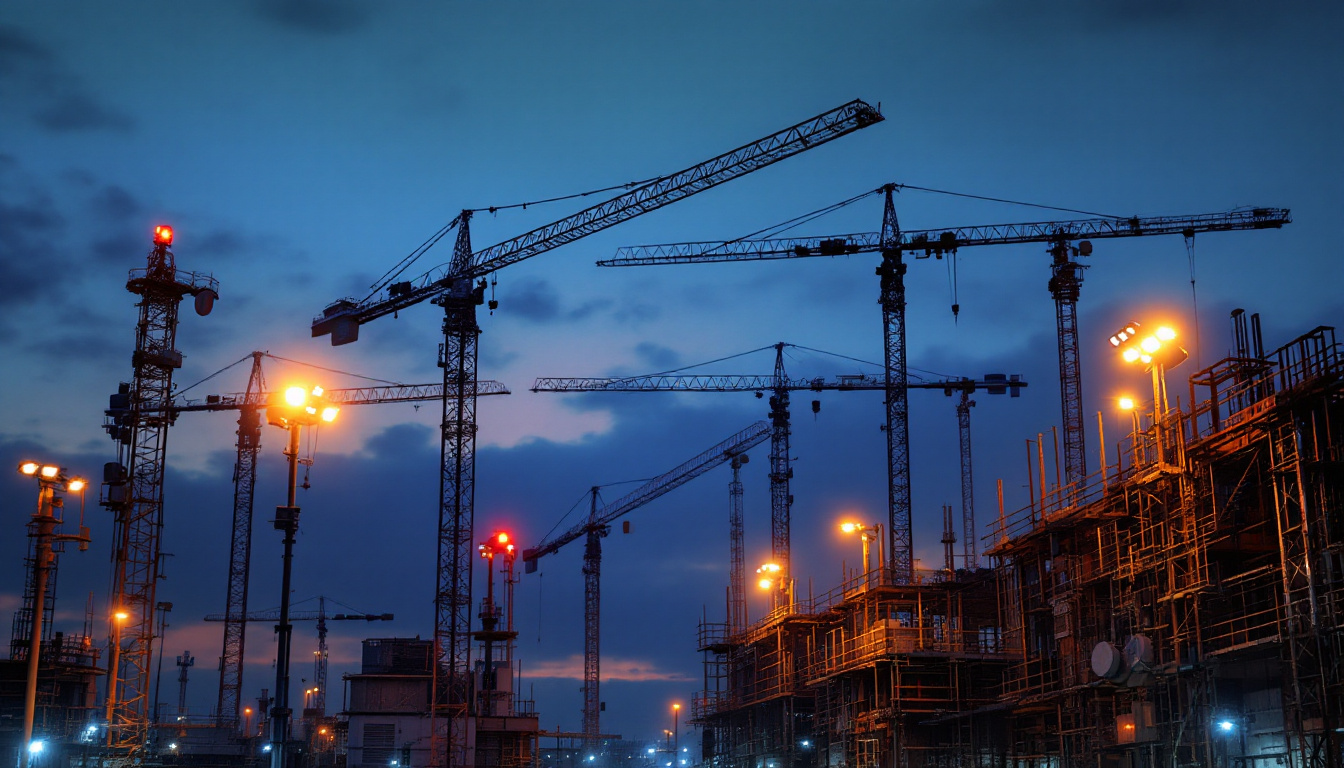
construction lights: Why it is Critical in Lighting Installations
In the realm of construction, proper lighting is not merely an accessory; it is a fundamental necessity. From enhancing safety to improving productivity, construction lights play a pivotal role in ensuring that projects are executed efficiently and effectively. This article delves into the importance of construction lights, their various types, and best practices for installation, all tailored for lighting contractors who seek to elevate their projects.
Construction sites are often fraught with hazards, and inadequate lighting can exacerbate these risks. Proper lighting is essential for various reasons, primarily focusing on safety and productivity.
One of the most critical functions of construction lighting is to enhance safety. Poor visibility can lead to accidents, injuries, and even fatalities. Construction workers need to see their surroundings clearly, especially when operating heavy machinery or working at heights. Well-placed and adequately bright lights can help illuminate potential hazards, ensuring that workers can navigate the site safely.
Moreover, construction lights can significantly reduce the risk of slips, trips, and falls, which are among the most common workplace accidents. By strategically positioning lights to cover walkways, scaffolding, and other high-risk areas, contractors can create a safer working environment. Furthermore, utilizing motion-sensor lights can provide an additional layer of safety by automatically illuminating areas as workers approach, thereby reducing the chances of accidents in dimly lit zones.
Beyond safety, effective lighting can enhance productivity on construction sites. When workers can see clearly, they can perform tasks more efficiently and with greater accuracy. This is particularly important for detailed work, such as electrical installations or plumbing, where precision is crucial.
Additionally, extended working hours are often necessary to meet project deadlines. Construction lights enable teams to work beyond daylight hours, maximizing the use of available time and resources. This flexibility can be a significant advantage in meeting tight schedules and ensuring project completion. Moreover, the psychological impact of proper lighting should not be overlooked; well-lit environments can boost morale and motivation among workers, leading to a more engaged and productive workforce. Studies have shown that adequate lighting can reduce fatigue and strain, allowing workers to maintain focus and energy throughout their shifts.
Furthermore, advancements in lighting technology, such as LED lights, offer not only energy efficiency but also enhanced brightness and longevity. These modern lighting solutions can be tailored to specific tasks, providing the right type of illumination for various activities on the construction site. For example, floodlights can be used for general site illumination, while task lights can focus on specific areas where detailed work is being performed. This versatility in lighting options further contributes to a safer and more productive work environment, ensuring that construction projects can progress smoothly and efficiently.
There are various types of construction lights available, each serving different purposes and environments. Understanding these options is essential for lighting contractors to choose the right solutions for their projects.
Temporary job site lights are commonly used in construction settings. These lights are designed to be portable and easy to set up, providing immediate illumination where it is needed most. They can be powered by electricity or generators, making them versatile for different site conditions.
LED floodlights are a popular choice for temporary lighting due to their energy efficiency and long lifespan. They provide bright, even illumination and can cover large areas, making them ideal for expansive construction sites. Additionally, many LED floodlights come with adjustable brightness settings, allowing contractors to customize the light output based on the specific requirements of the task at hand. This adaptability not only enhances visibility but also contributes to energy savings, as lights can be dimmed when full brightness is not necessary.
Task lighting is essential for specific activities that require focused illumination. This type of lighting is often used for detailed work, such as wiring, plumbing, or finishing touches. work lights, often adjustable and portable, can be positioned to shine directly on the area where work is being performed.
Using task lighting can help reduce eye strain and improve accuracy, leading to higher quality work and fewer mistakes. For contractors, investing in quality task lighting can pay off in the long run by minimizing rework and enhancing overall project quality. Furthermore, many modern task lights are equipped with features such as built-in battery packs for cordless operation, allowing for greater mobility on the job site. This feature is particularly beneficial in tight spaces or when working at heights, where maneuverability is crucial.
For larger construction sites, high-mast lighting is an effective solution. These lights are mounted on tall poles and can illuminate vast areas, making them ideal for projects that require extensive outdoor work, such as road construction or large commercial developments.
High-mast lights provide consistent illumination over a wide area, reducing shadows and dark spots that can create hazards. They are typically used in conjunction with other lighting types to ensure comprehensive coverage throughout the site. Additionally, the height of these lights allows them to be less susceptible to damage from equipment and materials that are frequently moved around on construction sites. Many high-mast lighting systems also incorporate smart technology, enabling remote control and monitoring, which can enhance safety and efficiency by allowing site managers to adjust lighting levels based on real-time needs and conditions.
To maximize the effectiveness of construction lights, contractors should follow best practices during installation. Proper planning and execution can significantly impact the safety and efficiency of the job site.
Before installing any lighting, conducting a thorough lighting assessment is crucial. This involves evaluating the site layout, identifying high-risk areas, and determining the specific lighting needs based on the tasks being performed. A well-planned lighting assessment can help ensure that all areas are adequately illuminated, minimizing the risk of accidents.
Consider factors such as the height of work areas, the types of tasks being performed, and the potential for shadows or glare. Engaging with workers to understand their needs can also provide valuable insights into where additional lighting may be necessary.
Selecting the appropriate lighting equipment is vital for achieving optimal results. Contractors should consider factors such as brightness, energy efficiency, and durability when choosing lights. LED lights are often favored for their long lifespan and low energy consumption, which can lead to significant cost savings over time.
Additionally, the ability to adjust the direction and intensity of light can enhance flexibility and effectiveness. Investing in high-quality equipment will not only improve safety and productivity but also reduce the need for frequent replacements or repairs.
Once the lighting is installed, regular maintenance and inspection are essential to ensure that it continues to function effectively. This includes checking for burnt-out bulbs, ensuring that lights are securely mounted, and cleaning fixtures to remove dust and debris that can reduce brightness.
Establishing a routine maintenance schedule can help identify issues before they become significant problems, ensuring that the site remains well-lit and safe for workers. Additionally, training workers to report any lighting issues can foster a culture of safety and accountability on the job site.
Adhering to local regulations and industry standards is crucial for lighting contractors. Compliance ensures that lighting installations meet safety requirements and protect workers on construction sites.
The Occupational Safety and Health Administration (OSHA) sets forth regulations regarding workplace safety, including lighting requirements for construction sites. Familiarizing oneself with these regulations is essential for contractors to ensure compliance and avoid potential penalties.
OSHA guidelines stipulate minimum illumination levels for various tasks and areas, emphasizing the importance of adequate lighting in preventing accidents. Contractors should stay informed about any updates to these regulations to maintain compliance and ensure worker safety.
In addition to regulatory compliance, following industry best practices can enhance the effectiveness of lighting installations. Engaging with professional organizations and staying updated on advancements in lighting technology can provide valuable insights for contractors.
Participating in training programs and workshops can also help contractors refine their skills and knowledge, leading to improved project outcomes. Networking with other professionals in the field can foster collaboration and the sharing of best practices, ultimately benefiting all involved in the construction process.
In summary, construction lights are a critical component of any lighting installation. Their role in enhancing safety, boosting productivity, and ensuring compliance with regulations cannot be overstated. By understanding the various types of construction lights available and adhering to best practices for installation and maintenance, lighting contractors can significantly improve the outcomes of their projects.
As the construction industry continues to evolve, staying informed about the latest advancements in lighting technology and regulations will be essential for contractors. By prioritizing effective lighting solutions, contractors can create safer, more efficient job sites that ultimately lead to successful project completions.
Investing in quality construction lights and implementing best practices will not only benefit the workers on site but also enhance the overall reputation of the contractor. In an industry where safety and efficiency are paramount, the importance of proper lighting cannot be overlooked.
Ready to enhance your construction sites with superior lighting solutions? At LumenWholesale, we provide lighting contractors with the highest quality, spec-grade construction lights at unbeatable wholesale prices. Say goodbye to local distributor markups and hello to our extensive selection that meets rigorous industry standards. With free shipping on bulk orders, you can equip your projects with reliable, high-performance lighting while enjoying the best value. Elevate your lighting installations today and experience the perfect blend of quality, affordability, and convenience. Wholesale Lighting at the Best Value is just a click away.

Discover how long LED lights are revolutionizing the lighting industry with their energy efficiency, longevity, and versatility.

Discover how motion lights for outside are revolutionizing modern lighting solutions by enhancing security, energy efficiency, and aesthetic appeal.

Discover the benefits and features of digital light timers in this comprehensive guide tailored for lighting contractors.

Discover the essential checklist for lighting contractors when installing outdoor recessed lights.